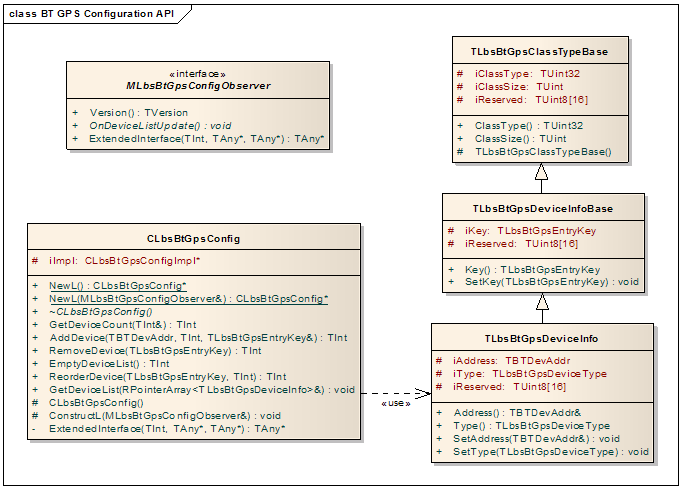Bluetooth GPS PSY Configuration API Overview
This document describes the Bluetooth GPS PSY Configuration API and is aimed at application developers who want to create applications for managing a list of Bluetooth GPS devices.
Purpose
A developer can use the Bluetooth GPS PSY Configuration API to write an application to manage a list of Bluetooth GPS devices. The list of devices is in order of preference. When GPS position information is required, the Bluetooth GPS PSY reads the list and attempts to connect to the first device address listed. If the connection is unsuccessful, then the Bluetooth GPS PSY tries each device in the list, in the order in which they are specified, until a connection is made. If the end of the list is reached, the Bluetooth GPS PSY requests for another device (not on the list) to be selected via the client application.
The Bluetooth GPS PSY Configuration API stores the list in its own repository.
Library details
The DLL that provides the functionality and the library to which your code must link is identified below.
Architecture
The following diagram shows the Bluetooth GPS PSY Configuration API class structure:
Description
The Bluetooth GPS PSY Configuration API provides the following types of functions:
Querying
The following functions return information about the preferred list:
CLbsBtGpsConfig::GetDeviceListL(RPointerArray<TLbsBtGpsDeviceInfo>&) - returns the list of devices.
CLbsBtGpsConfig::GetDeviceCount(TInt&) - returns the number of devices in the list.
Configuring
The following functions enable the preferred list to be configured:
CLbsBtGpsConfig::AddDevice(const TBTDevAddr&, TInt, TLbsBtGpsEntryKey&) - adds a new device to the list, at a specified position.
CLbsBtGpsConfig::ReorderDevice(TLbsBtGpsEntryKey, TInt) - moves a device to a new position in the list.
CLbsBtGpsConfig::RemoveDevice(TLbsBtGpsEntryKey) - removes a device from the list.
CLbsBtGpsConfig::EmptyDeviceList() - removes all of the devices from the list.
APIs
The key classes of Bluetooth GPS PSY Configuration API are as follows:
Using the Bluetooth GPS PSY Configuration API
The following tutorials describe how to use the Bluetooth GPS PSY Configuration API:
Copyright ©2010 Nokia Corporation and/or its subsidiary(-ies).
All rights
reserved. Unless otherwise stated, these materials are provided under the terms of the Eclipse Public License
v1.0.
